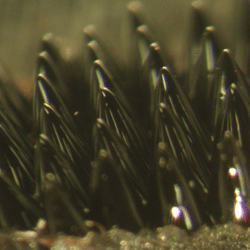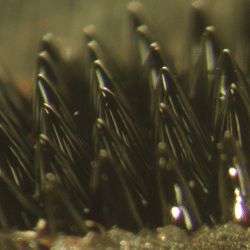The new wave
As two waves merge—say in a lake or in an elastic string—they normally add together and resume their initial shape as they continue on their original paths. But if the waves are particularly large or numerous, they may interact nonlinearly, causing energy to distribute over a large number of wavelengths. This leads to a fully developed state of wave turbulence.
Writing in Physical Review Letters, François Boyer and Eric Falcon, both at the Université Paris Diderot, have designed a wave turbulent system that they can control with a magnetic field: a suspension of magnetic nanoparticles called a ferrofluid. In a typical fluid, the motion of surface waves is dominated by gravity at long wavelengths and by surface tension at short wavelengths. In a ferrofluid, the presence of a magnetic field acts against these forces and, depending on the strength of the field, alters the speed at which waves travel. Such a system allows the French team to explore the limits of wave turbulence theory in various regimes.
In their experiments, Boyer and Falcon partially fill a cylinder with a ferrofluid in a magnetic field and excite the fluid surface with a wave maker. A probe monitors the height of the fluid as it varies in time to determine how energy is distributed over the different wavelengths. This energy distribution is characteristic of whether the wave turbulence is dominated by gravity, capillary, or magnetic forces and the authors are able to observe all three regimes, as well as a triple-point of coexistence between them. – Jessica Thomas





